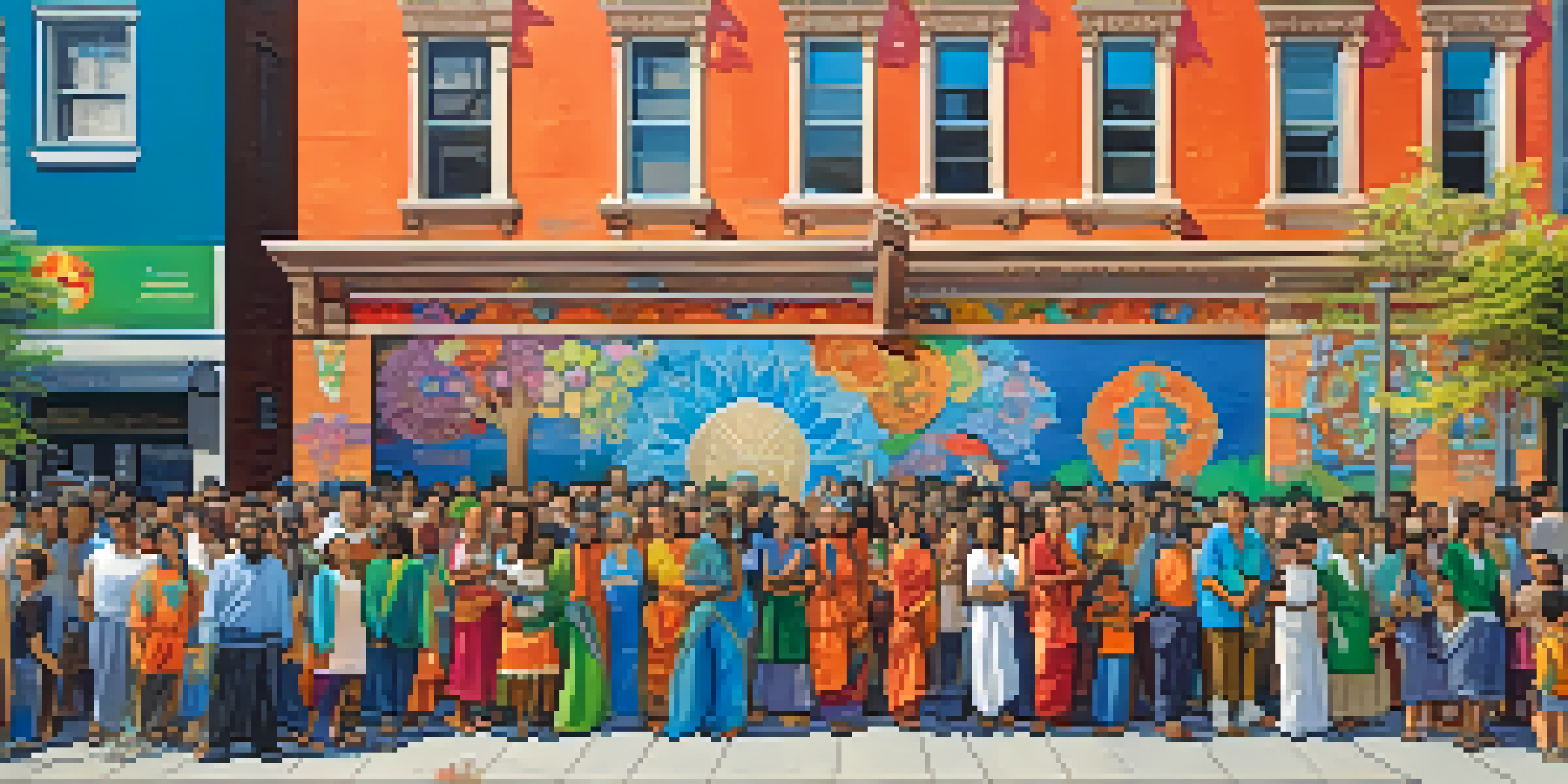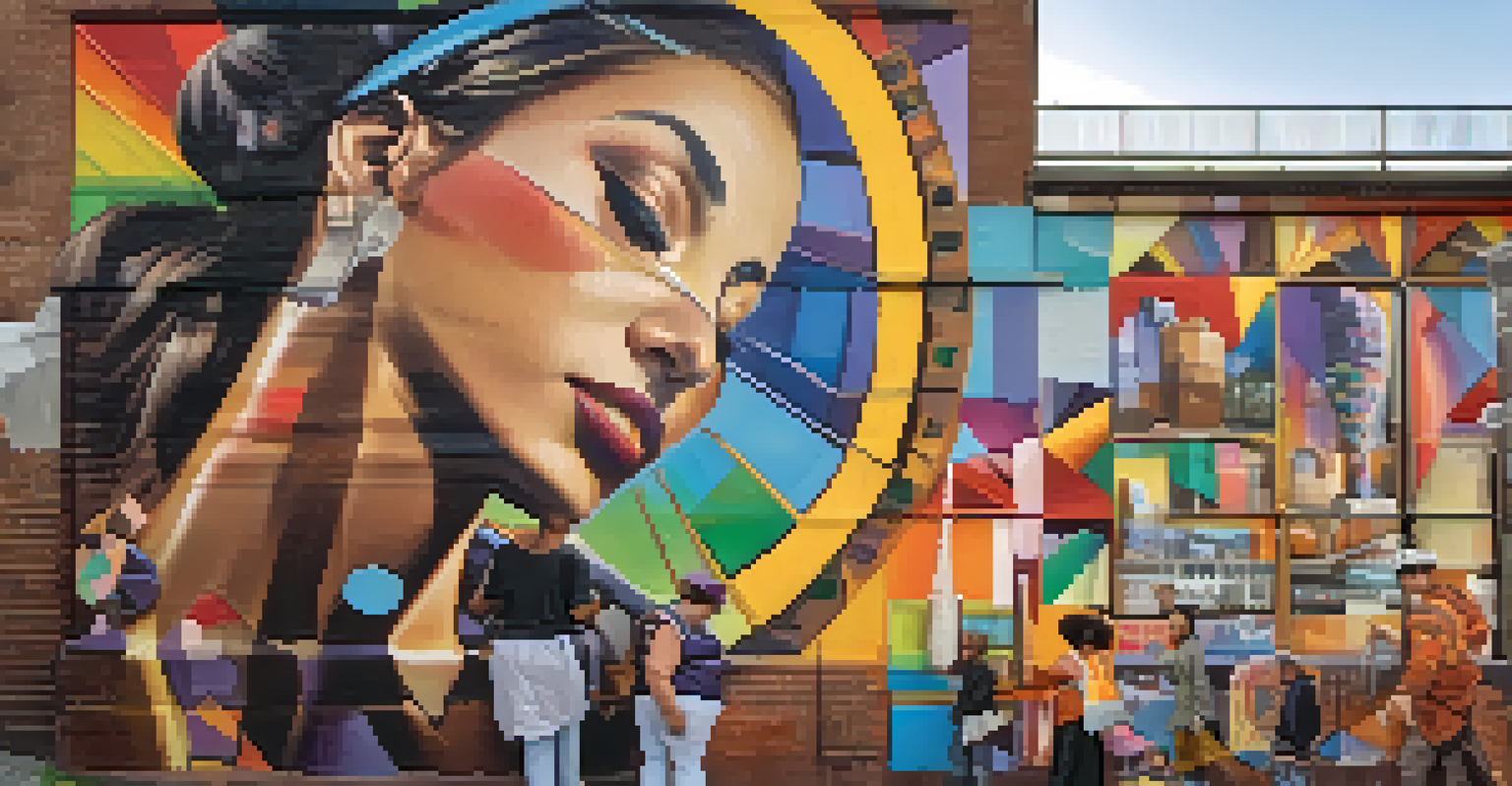Street Art: A Canvas for Social Justice and Resistance

Street Art: A Unique Form of Expression
Street art is more than just graffiti; it’s a vibrant form of expression that captures the pulse of a community. Unlike traditional art confined to galleries, street art is accessible to everyone, allowing artists to communicate messages directly to the public. This accessibility fosters a connection between the artist and the audience, making it a powerful tool for social commentary.
Art is not a mirror to hold up to society, but a hammer with which to shape it.
For instance, think of the iconic murals that popped up during significant movements like Black Lives Matter. These artworks not only beautify urban spaces but also convey urgent social messages, sparking conversations that might not happen otherwise. In this way, street art becomes a voice for the voiceless, amplifying issues that deserve attention.
Moreover, street art often reflects the cultural and political landscape of the area it inhabits. From vibrant murals to thought-provoking stencils, each piece tells a story, shedding light on social injustices, inequality, and resistance. As such, street art is a canvas where communities express their struggles, hopes, and desires for change.
Historical Roots of Street Art and Activism
The roots of street art can be traced back to various movements, with origins in the 1960s counterculture. Artists began using public spaces to voice their dissent against political issues, such as the Vietnam War and civil rights violations. This tradition of using art as a form of protest laid the groundwork for today's street artists who tackle contemporary issues.

For example, the works of early graffiti artists like Keith Haring and Jean-Michel Basquiat emerged from a desire to challenge societal norms and highlight marginalized voices. Their art was not just about aesthetics; it was a reaction to the injustices they witnessed, serving as a precursor to the politically charged street art we see today.
Street Art as Community Voice
Street art acts as a powerful medium for communities to express their struggles and hopes, fostering dialogue and connection among residents.
This historical context is crucial as it highlights how street art has always been a tool for resistance. Each mural or tagging can be seen as a continuation of a long-standing tradition where art intersects with activism, reminding us that public spaces can be arenas for social change.
The Role of Social Media in Street Art
In today’s digital age, social media plays a pivotal role in the proliferation of street art. Platforms like Instagram and TikTok allow artists to share their works globally, reaching audiences far beyond their local communities. This has helped elevate street art from a niche interest to a recognized form of cultural expression.
The role of the artist is to make the revolution irresistible.
Consider how viral street art pieces can spark movements overnight. For instance, the 'Girl with a Balloon' by Banksy gained international attention through social media, leading to discussions on consumerism and authenticity in art. These digital platforms not only showcase the art but also connect viewers to the stories and messages behind the works.
Furthermore, social media has created a sense of community among street artists and activists. Artists can collaborate, share ideas, and inspire one another, fostering a global network of individuals dedicated to using their talents for social justice. In this way, social media amplifies the impact of street art, turning local issues into global conversations.
Street Art as a Tool for Community Engagement
Street art has the unique ability to engage communities in meaningful dialogue. By creating works that reflect local issues, artists invite residents to confront and discuss their societal challenges. This engagement fosters a sense of ownership and pride within the community, as individuals see their experiences reflected in public art.
For example, community murals often emerge from collaborative projects where residents contribute ideas or even paint alongside artists. These collective efforts not only beautify neighborhoods but also strengthen community bonds, as people come together to address common concerns through creativity. It’s a powerful reminder that art can unite rather than divide.
Art as a Tool for Activism
Historically rooted in activism, street art challenges societal norms and political structures, amplifying marginalized voices and promoting social change.
Moreover, street art can serve as a catalyst for change, encouraging communities to take action. When a mural highlights local struggles, it can inspire residents to organize, advocate, and seek solutions. Thus, street art becomes more than mere decoration; it transforms into a movement that empowers individuals to make a difference.
Challenging Political Structures through Art
Street art often serves as a direct challenge to political structures and authority. Artists use public spaces to critique government policies, social injustices, and inequalities that might otherwise go unchallenged. This boldness reflects a larger desire for accountability and transparency, making street art a form of resistance.
Consider the powerful murals that emerged during protests in countries like Venezuela and Iran, where artists used their craft to oppose oppressive regimes. These artworks not only document resistance but also inspire others to take a stand against injustice. In these contexts, street art becomes an act of bravery, challenging the status quo with creativity.
Furthermore, the ephemeral nature of street art adds to its rebellious spirit. Many pieces are created in secrecy, risking vandalism charges or removal, yet artists persist because their messages are crucial. This element of risk transforms street art into a form of protest that is both urgent and compelling, embodying the essence of resistance.
The Impact of Street Art on Policy and Change
The influence of street art extends beyond aesthetics; it can impact policy and drive social change. By bringing attention to critical issues, artists can create pressure on local governments to address concerns highlighted in their work. This phenomenon has led to policy discussions centered around issues like housing, education, and public health.
For example, murals addressing homelessness can prompt city officials to reevaluate their approaches to social services. When art makes these issues visible, it encourages dialogue among community leaders and residents, fostering a collaborative approach to problem-solving. Thus, street art can serve as a bridge between citizens and policymakers.
Social Media's Amplifying Role
Social media enhances the reach of street art, transforming local issues into global conversations and creating a network of artists dedicated to social justice.
Moreover, successful campaigns often feature street art as a central element, illustrating its power to mobilize communities. By incorporating art into activism, movements can attract a wider audience and inspire collective action, ultimately leading to tangible changes. In this sense, street art is not just a form of expression but a strategic tool for advocacy.
The Future of Street Art in Social Movements
As social movements evolve, so too does the role of street art within them. Artists are increasingly using their platforms to address emerging issues such as climate change, racial justice, and gender equality. This adaptability ensures that street art remains relevant and continues to serve as a reflection of societal concerns.
Looking ahead, we can expect to see more collaborations between street artists and activists, creating a fusion of creativity and advocacy. This synergy can lead to innovative campaigns that harness the power of visual art to inspire action and drive change. With each new generation, street art reinvents itself, responding to the ever-changing landscape of social justice.

Ultimately, the future of street art is bright, as it remains a vital medium for resistance and expression. As long as there are injustices to address, artists will find ways to communicate their messages through vibrant murals and thought-provoking installations. Street art will continue to be a canvas for social justice, inspiring individuals to stand up and make their voices heard.